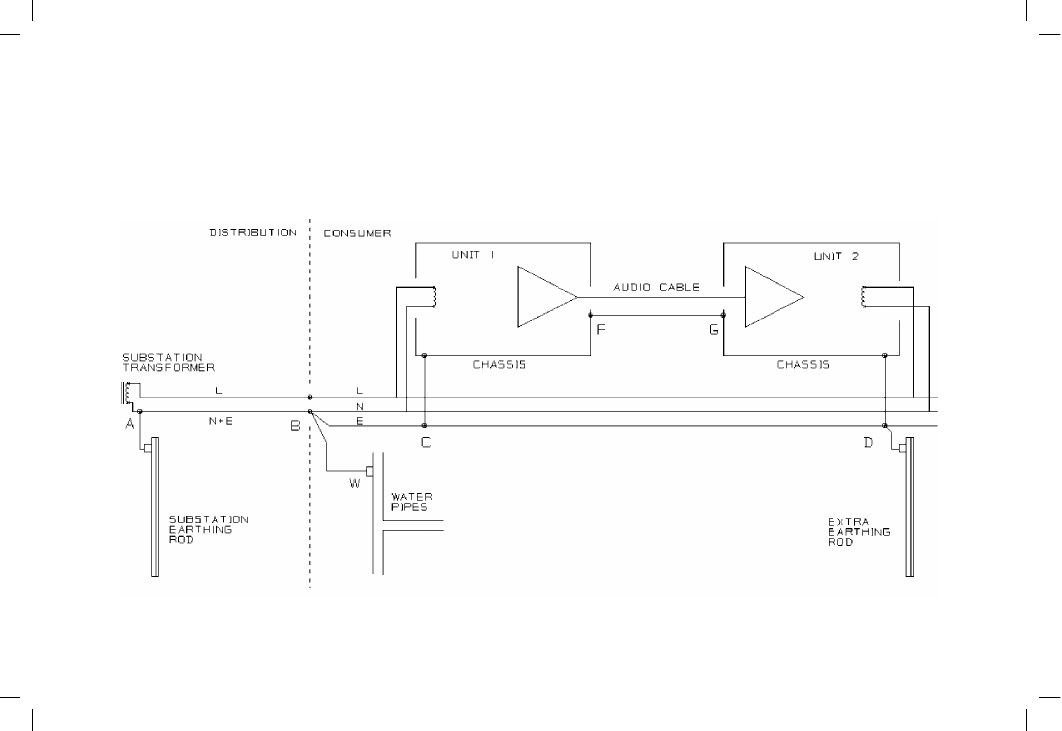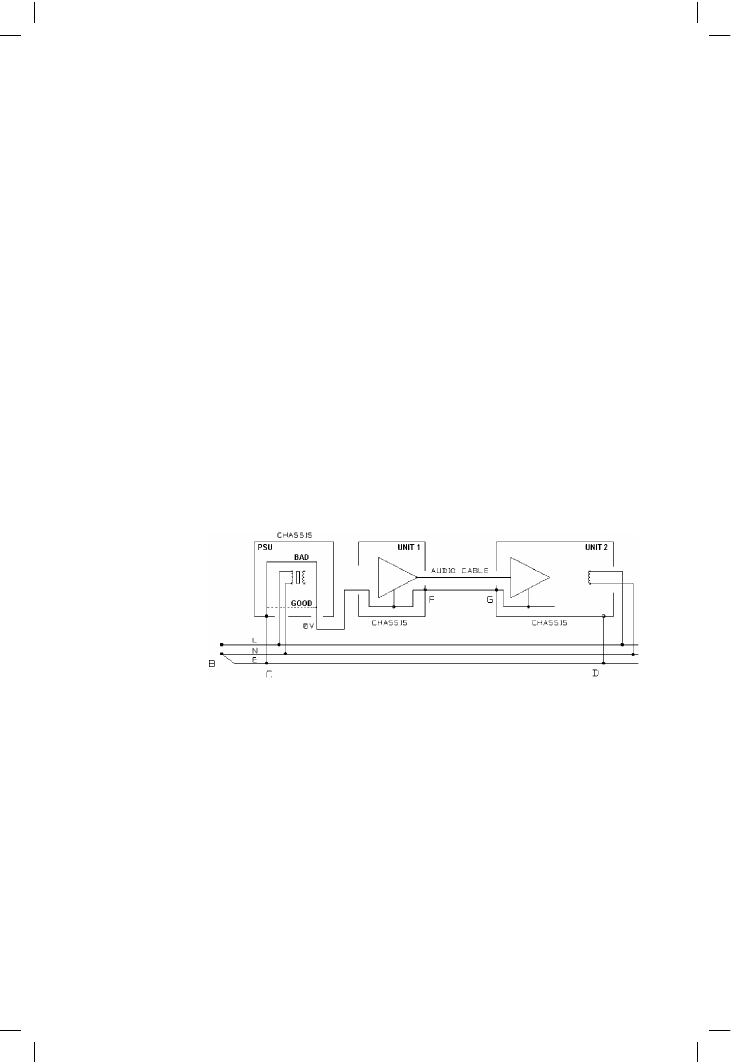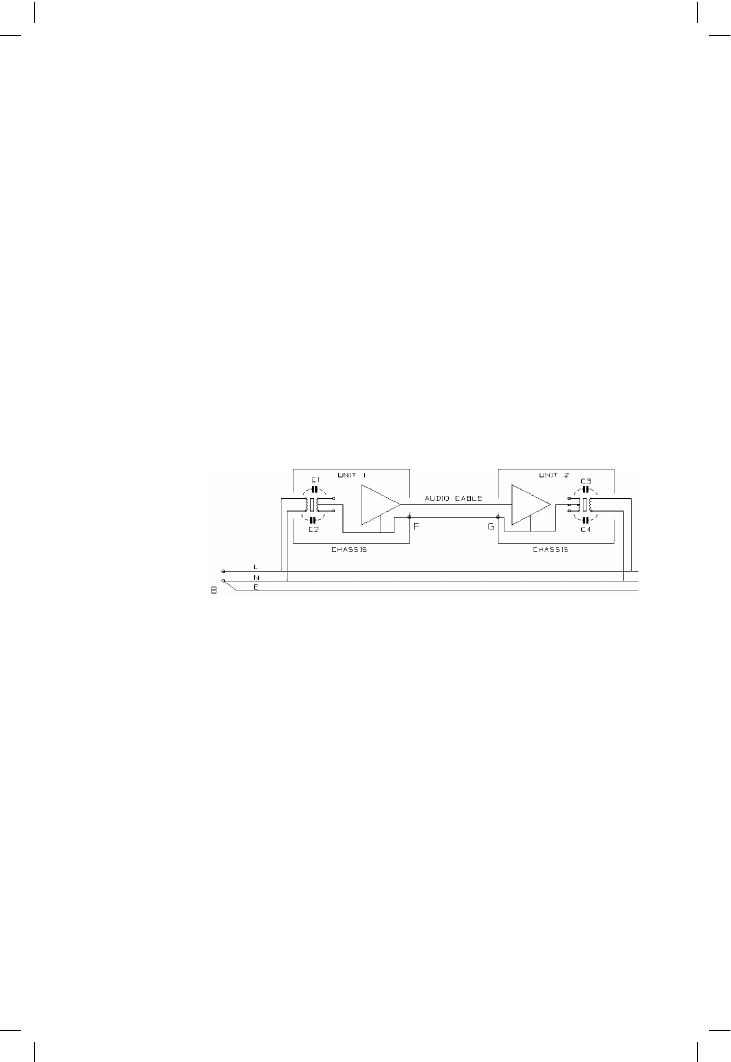ВУЗ: Казахская Национальная Академия Искусств им. Т. Жургенова
Категория: Учебное пособие
Дисциплина: Не указана
Добавлен: 03.02.2019
Просмотров: 17345
Скачиваний: 18

Grounding and practical matters
resistance across which signal currents will cause unwanted voltage-drops.
The best method is to keep ground currents apart by means of a suitable
connection topology, such as a separate ground return to the Star Point for
the local HT decoupling, but when this is not practical it is necessary to
make every ground track as thick as possible, and fattened up with copper
at every possible point. It is vital that the ground path has no necks or
narrow sections, as it is no stronger than the weakest part. If the ground
path changes board side then a single via-hole may be insufficient, and
several should be connected in parallel. Some CAD systems make this
difficult, but there is usually a way to fool them.
Power amplifiers rarely use double-insulated construction and so the
chassis and all metalwork must be permanently and solidly grounded for
safety; this aspect of grounding is covered in Chapter 15. One result of
permanent chassis grounding is that an amplifier with unbalanced inputs
may appear susceptible to ground loops. One solution is to connect audio
ground to chassis only through a 10 ! resistor, which is large enough to
prevent loop currents becoming significant. This is not very satisfactory
as:
!
The audio system as a whole may thus not be solidly grounded.
!
If the resistor is burnt out due to misconnected speaker outputs, the
audio circuitry is floating and could become a safety hazard.
!
The RF rejection of the power amplifier is likely to be degraded. A 100 nF
capacitor across the resistor may help.
A better approach is to put the audio-chassis ground connection at the
input connector, so in Figure 14.1, ground-loop currents must flow through
A–B to the Protected Earth at B, and then to mains ground via B–C. They
cannot flow through the audio path E–F. This topology is very resistant to
ground-loops, even with an unbalanced input; the limitation on system
performance in the presence of a ground-loop is now determined by the
voltage-drop in the input cable ground, which is outside the control of the
amplifier designer. A balanced input could in theory cancel out this voltage
drop completely.
Figure 14.1 also shows how the other grounding requirements are met. The
reservoir charging pulses are confined to the connection D–E, and do not
flow E–F, as there is no other circuit path. E–F–H carries ripple, etc. from
the local HT decouplers, but likewise cannot contaminate the crucial audio
ground A–G.
Ground loops: how they work and how to deal with them
A ground loop is created whenever two or more pieces of mains-powered
equipment are connected together, so that mains-derived AC flows through
shields and ground conductors, degrading the noise floor of the system. The
effect is worst when two or more units are connected through mains ground
405

Audio Power Amplifier Design Handbook
as well as audio cabling, and this situation is what is normally meant by the
term ‘ground loop’. However, ground currents can also flow in systems that
are not galvanically grounded; they are of lower magnitude but can still
degrade the noise floor, so this scenario is also considered here.
The ground currents may either be inherent in the mains supply wiring (see
‘Hum injection by mains grounding currents’ below) or generated by one
or more of the pieces of equipment that make up the audio system (see
sections ‘Hum injection by transformer stray magnetic fields’ and ‘Hum
injection by ‘transformer stray capacitance’ below).
Once flowing in the ground wiring, these currents will give rise to voltage
drops that introduce hum and buzzing noises. This may occur either in the
audio interconnects, or inside the equipment itself if it is not well designed.
See section ‘Ground currents inside equipment’, on p. 410.
Here I have used the word ‘ground’ for conductors and so on, while ‘earth’
is reserved for the damp crumbly stuff into which copper rods are thrust.
Hum injection by mains grounding currents
Figure 14.2 shows what happens when a so-called ‘technical ground’ such
as a buried copper rod is attached to a grounding system which is already
connected to ‘mains ground’ at the power distribution board. The latter is
mandatory both legally and technically, so one might as well accept this
and denote as the reference ground. In many cases this ‘mains ground’ is
actually the neutral conductor, which is only grounded at the remote
transformer substation. AB is the cable from substation to consumer, which
serves many houses from connections tapped off along its length. There is
substantial current flowing down the N + E conductor, so point B is often
1 volt rms or more above earth. From B onwards, in the internal house
wiring, neutral and ground are always separate (in the UK, anyway).
Two pieces of audio equipment are connected to this mains wiring at C and
D, and joined to each other through an unbalanced cable F–G. Then an ill-
advised connection is made to earth at D; the 1 V rms is now impressed on
the path B–C–D, and substantial current is likely to flow through it,
depending on the total resistance of this path. There will be a voltage drop
from C to D, its magnitude depending on what fraction of the total BCDE
resistance is made up by the section C–D. The earth wire C–D will be of
at least 1.5 mm
2
cross-section, and so the extra connection FG down the
audio cable is unlikely to reduce the interfering voltage much.
To get a feel for the magnitudes involved, take a plausible ground current
of 1 amp. The 1.5 mm
2
ground conductor will have a resistance of
0.012 !/metre, so if the mains sockets at C and D are one metre apart, the
voltage C–D will be 12 mV rms. Almost all of this will appear between F
and G, and will be indistinguishable from wanted signal to the input stage
406

Figure 14.2
The pitfalls of adding a ‘technical ground’ to a system which is already grounded via the mains

Audio Power Amplifier Design Handbook
of Unit 2, so the hum will be severe, probably only 30 dB below the
nominal signal level.
The best way to solve this problem is not to create it in the first place. If
some ground current is unavoidable then the use of balanced inputs (or
ground-cancel outputs – it is not necessary to use both) should give at least
40 dB of rejection at audio frequencies.
Figure 14.2 also shows a third earthing point, which fortunately does not
complicate the situation. Metal water pipes are bonded to the incoming
mains ground for safety reasons, and since they are usually electrically
connected to an incoming water supply current flows through B–W in the
same way as it does through the copper rod link D–E. This water-pipe
current does not, however, flow through C–D and cannot cause a ground-
loop problem. It may, however, cause the pipes to generate an AC magnetic
field which is picked up by other wiring.
Hum injection by transformer stray magnetic fields
Figure 14.3 shows a thoroughly bad piece of physical layout which will
cause ground currents to flow even if the system is correctly grounded to
just one point.
Here Unit 1 has an external DC power supply; this makes it possible to use
an inexpensive frame-type transformer which will have a large stray field.
But note that the wire in the PSU which connects mains ground to the
outgoing 0 V takes a half-turn around the transformer, and significant
current will be induced into it, which will flow round the loop C–F–G–D,
and give an unwanted voltage drop between F and G. In this case
reinforcing the ground of the audio interconnection is likely to be of some
help, as it directly reduces the fraction of the total loop voltage which is
dropped between F and G.
It is difficult to put any magnitudes to this effect because it depends on
many imponderables such as the build quality of the transformer and the
exact physical arrangement of the ground cable in the PSU. If this cable is
408
Figure 14.3
Poor cable layout in
the PSU at left wraps a
loop around the
transformer and
induces ground
currents

Grounding and practical matters
rerouted to the dotted position in the diagram, the transformer is no longer
enclosed in a half-turn, and the effect will be much smaller.
Hum injection by transformer stray capacitance
It seems at first sight that the adoption of Class II (double-insulated)
equipment throughout an audio system will give inherent immunity to
ground-loop problems. Life is not so simple, though it has to be said that
when such problems do occur they are likely to be much less severe. This
problem afflicts all Class II equipment to a certain extent.
Figure 14.4 shows two Class II units connected together by an unbalanced
audio cable. The two mains transformers in the units have stray
capacitance from both live and neutral to the secondary. If these
capacitances were all identical no current would flow, but in practice they
are not, so 50 Hz currents are injected into the internal 0 V rail and flow
through the resistance of F–G, adding hum to the signal. A balanced input
or ground-cancelling output will remove or render negligible the ill-effects.
Reducing the resistance of the interconnect ground path is also useful –
more so than with other types of ground loop, because the ground current
is essentially fixed by the small stray capacitances, and so halving the
resistance F–G will dependably halve the interfering voltage. There are
limits to how far you can take this – while a simple balanced input will give
40 dB of rejection at low cost, increasing the cross-sectional area of copper
in the ground of an audio cable by a factor of 100 times is not going to be
either easy or cheap. Figure 14.4 shows equipment with metal chassis
connected to the 0 V (this is quite acceptable for safety approvals – what
counts is the isolation between mains and everything else, not between
low-voltage circuitry and touchable metalwork); note the chassis connec-
tion, however, has no relevance to the basic effect, which would still occur
even if the equipment enclosure was completely non-conducting.
The magnitude of ground current varies with the details of transformer
construction, and increases as the size of the transformer grows. Therefore
the more power a unit draws, the larger the ground current it can sustain.
This is why many systems are subjectively hum-free until the connection of
409
Figure 14.4
The injection of mains
current into the ground
wiring via transformer
inter-winding
capacitance